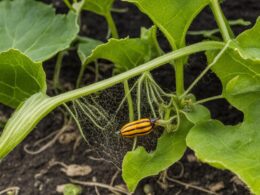Do you want to reduce waste and boost your garden’s health at the same time? Composting citrus scraps may be the solution for you!
Not only can it help divert food waste from landfills, but it can also provide your garden with nutrient-rich soil that promotes plant growth. Citrus scraps, including peels, rinds, and pulp, are often considered as waste.
However, by composting them, you can turn them into a valuable resource for your garden. In this article, you will learn about the benefits of composting citrus, which types of citrus are best for composting, and tips for effective composting.
So, let’s dive in and discover how you can reduce waste and give your garden a boost!
Quick Takeaways
- Citrus scraps, including peels, rinds, and pulp, can be composted and add nitrogen to the pile, but they take longer to break down due to the d-limonene chemical found in the fruit skin.
- Lemon waste can increase the acidity of the compost pile and may lead to an off-putting odor, but certain plants like rhododendrons, azaleas, and camellias can benefit from compost made with lots of lemon and orange waste.
- Citrus scraps should be broken down into small pieces for better exposure to bacteria and balanced with an equal amount of a bulking agent like dry leaves. Moldy citrus scraps can be covered with grass or paper and placed in the center of the compost pile for faster decomposition.
- Composting citrus scraps can help reduce waste sent to landfills and enrich the final compost medium, but hot composting piles are more effective at killing off seeds than cold composting piles.
Benefits of Composting Citrus
You can boost your garden’s nutrient levels by composting citrus scraps. Not only do they add nitrogen, but they also introduce potassium and phosphorus to the compost heap. This makes them an excellent addition to any compost pile, especially if you’re looking to add some variety to your compost mix.
Using citrus compost for acid-loving plants, such as rhododendrons, azaleas, and camellias, can be especially beneficial. These plants thrive in soil that’s slightly acidic, and the added acidity from the citrus compost can help them grow stronger and healthier.
Additionally, the scent of citrus can help deter pests and bugs from your garden, making it an all-around great addition to your composting routine.
Should I Cover My Compost Pile to Reduce Citrus Scraps?
Covering your compost pile is beneficial for reducing citrus scraps. However, composting without cover has its advantages too. While covering can prevent pests and retain moisture, leaving it uncovered allows better airflow and promotes decomposition. Consider your composting goals and environmental factors to decide whether to cover or not.
Types of Citrus to Compost
Lemons, oranges, grapefruits, and limes are all examples of citrus fruits that can be added to your compost pile. Not only do they help reduce waste, but they also provide essential nutrients to your garden soil.
Here are three types of citrus that can benefit your compost pile:
-
Oranges – Oranges are rich in nitrogen, potassium, and phosphorus, making them an excellent addition to your compost pile. They also have a high water content, which helps keep the compost moist.
-
Lemons – Although lemon waste can raise the acidity of your compost pile, it can benefit acid-loving plants like rhododendrons, azaleas, and camellias. Just be sure to balance the lemon scraps with an equal amount of dry leaves or other bulking agents.
-
Grapefruits – Grapefruit peels are high in fiber and can help improve the structure of your compost pile. They also contain essential nutrients like vitamin C and potassium, which can benefit your plants.
When composting citrus scraps, it’s important to consider the composting methods you’re using. Hot composting piles can reach high enough temperatures to kill off any seeds in the citrus fruit, while cold composting piles may not generate enough heat. Additionally, be sure to balance the citrus scraps with other compost materials and break them down into small pieces for better decomposition.
With a little attention to detail, you can turn your citrus scraps into a nutrient-rich compost that’ll benefit your garden for years to come.
Tips for Effective Composting
To effectively create nutrient-rich compost, it’s important to break down citrus into smaller pieces. This allows for better exposure to bacteria and helps speed up the decomposition process. You can break citrus scraps down by chopping them up with a knife or using a food processor.
Once they are broken down, it’s important to balance the citrus with other compost materials like dry leaves or grass. This will help create a balanced mix of nitrogen and carbon, which is essential for healthy compost.
When composting citrus scraps, it’s important to use a composting container to keep the scraps contained and reduce odors. You can use a lidded bucket or a compost bin specifically designed for this purpose.
Additionally, moldy citrus scraps should be covered with grass or paper and placed in the center of the compost pile for faster decomposition. Following these tips will help you effectively compost citrus scraps and reduce waste sent to landfills.
Frequently Asked Questions
Can citrus scraps attract pests or animals to the compost pile?
To prevent pests from being attracted to your compost pile, maintain proper composting practices. Make sure to balance the citrus scraps with a bulking agent and cover them with grass or paper. Properly maintained compost piles should deter animals and bugs.
Is it okay to compost citrus scraps with other types of food waste?
You can compost citrus scraps with other food waste, but it’s best to balance the mix with a bulking agent like dry leaves. Alternatively, use citrus peels for alternative uses like cleaning or flavoring. Citrus composting benefits your garden by adding nitrogen and other nutrients.
How long does it typically take for citrus scraps to break down in a compost pile?
Citrus scraps can take longer to break down in a compost pile due to the d-limonene chemical. Best methods for composting citrus scraps include breaking them down into small pieces and balancing with a bulking agent. The citrus composting timeline can range from 3-12 months.
Can compost made with citrus scraps be used in vegetable gardens?
Yes, you can use compost made with citrus scraps in your vegetable garden. Citrus scraps provide natural fertilizer and enrich the soil with nitrogen, potassium, and phosphorus. The benefits of composting with citrus scraps are numerous.
Are there any safety concerns when composting citrus scraps, such as potential chemical residues?
When composting citrus scraps, be aware of potential chemical residues from pesticides. Always wash and peel the fruit before composting. Follow citrus scrap composting tips for safe and beneficial results.
Conclusion
Now that you know the benefits of composting citrus scraps, it’s time to start doing it! Start collecting your citrus scraps and add them to your compost pile.
Remember to balance the citrus scraps with other materials such as leaves, grass clippings, or shredded paper.
By composting citrus scraps, you’re not only reducing waste but also enriching your garden with nutrient-rich soil. Your plants will thank you for it by growing stronger and healthier.
So why not give it a try and see the difference it makes in your garden? Happy composting!








